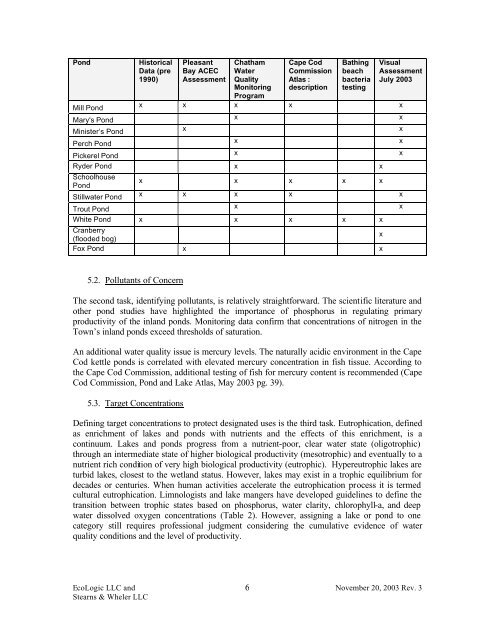Action Plan for the Town of Chatham Ponds
rev 3a report.pdf - Town to Chatham
rev 3a report.pdf - Town to Chatham
Create successful ePaper yourself
Turn your PDF publications into a flip-book with our unique Google optimized e-Paper software.
Pond<br />
Historical<br />
Data (pre<br />
1990)<br />
Pleasant<br />
Bay ACEC<br />
Assessment<br />
<strong>Chatham</strong><br />
Water<br />
Quality<br />
Monitoring<br />
Program<br />
Cape Cod<br />
Commission<br />
Atlas :<br />
description<br />
Bathing<br />
beach<br />
bacteria<br />
testing<br />
Visual<br />
Assessment<br />
July 2003<br />
Mill Pond<br />
x x x x x<br />
Mary's Pond<br />
x<br />
x<br />
Minister’s Pond<br />
x<br />
x<br />
Perch Pond<br />
x<br />
x<br />
Pickerel Pond<br />
x<br />
x<br />
Ryder Pond x x<br />
Schoolhouse<br />
Pond<br />
x x x x x<br />
Stillwater Pond<br />
x x x x x<br />
Trout Pond<br />
x<br />
x<br />
White Pond x x x x x<br />
Cranberry<br />
(flooded bog)<br />
x<br />
Fox Pond x x<br />
5.2. Pollutants <strong>of</strong> Concern<br />
The second task, identifying pollutants, is relatively straight<strong>for</strong>ward. The scientific literature and<br />
o<strong>the</strong>r pond studies have highlighted <strong>the</strong> importance <strong>of</strong> phosphorus in regulating primary<br />
productivity <strong>of</strong> <strong>the</strong> inland ponds. Monitoring data confirm that concentrations <strong>of</strong> nitrogen in <strong>the</strong><br />
<strong>Town</strong>’s inland ponds exceed thresholds <strong>of</strong> saturation.<br />
An additional water quality issue is mercury levels. The naturally acidic environment in <strong>the</strong> Cape<br />
Cod kettle ponds is correlated with elevated mercury concentration in fish tissue. According to<br />
<strong>the</strong> Cape Cod Commission, additional testing <strong>of</strong> fish <strong>for</strong> mercury content is recommended (Cape<br />
Cod Commission, Pond and Lake Atlas, May 2003 pg. 39).<br />
5.3. Target Concentrations<br />
Defining target concentrations to protect designated uses is <strong>the</strong> third task. Eutrophication, defined<br />
as enrichment <strong>of</strong> lakes and ponds with nutrients and <strong>the</strong> effects <strong>of</strong> this enrichment, is a<br />
continuum. Lakes and ponds progress from a nutrient-poor, clear water state (oligotrophic)<br />
through an intermediate state <strong>of</strong> higher biological productivity (mesotrophic) and eventually to a<br />
nutrient rich condition <strong>of</strong> very high biological productivity (eutrophic). Hypereutrophic lakes are<br />
turbid lakes, closest to <strong>the</strong> wetland status. However, lakes may exist in a trophic equilibrium <strong>for</strong><br />
decades or centuries. When human activities accelerate <strong>the</strong> eutrophication process it is termed<br />
cultural eutrophication. Limnologists and lake mangers have developed guidelines to define <strong>the</strong><br />
transition between trophic states based on phosphorus, water clarity, chlorophyll-a, and deep<br />
water dissolved oxygen concentrations (Table 2). However, assigning a lake or pond to one<br />
category still requires pr<strong>of</strong>essional judgment considering <strong>the</strong> cumulative evidence <strong>of</strong> water<br />
quality conditions and <strong>the</strong> level <strong>of</strong> productivity.<br />
EcoLogic LLC and 6<br />
November 20, 2003 Rev. 3<br />
Stearns & Wheler LLC
















